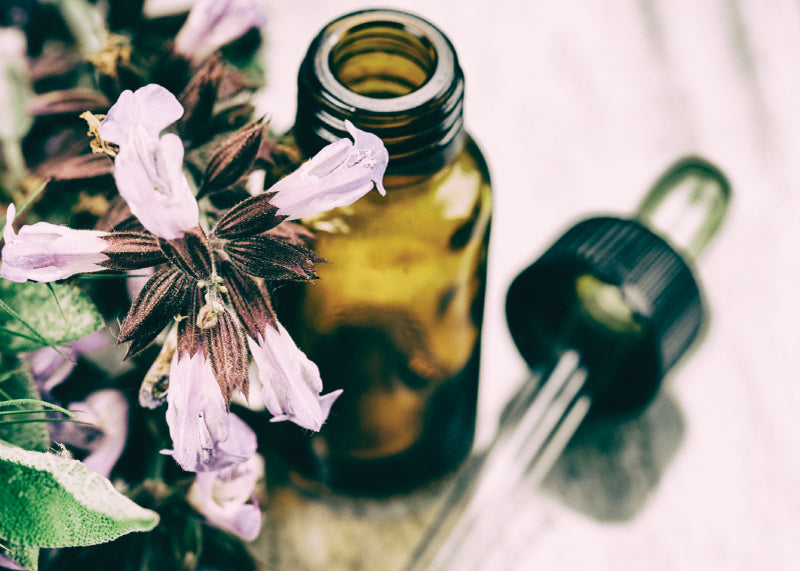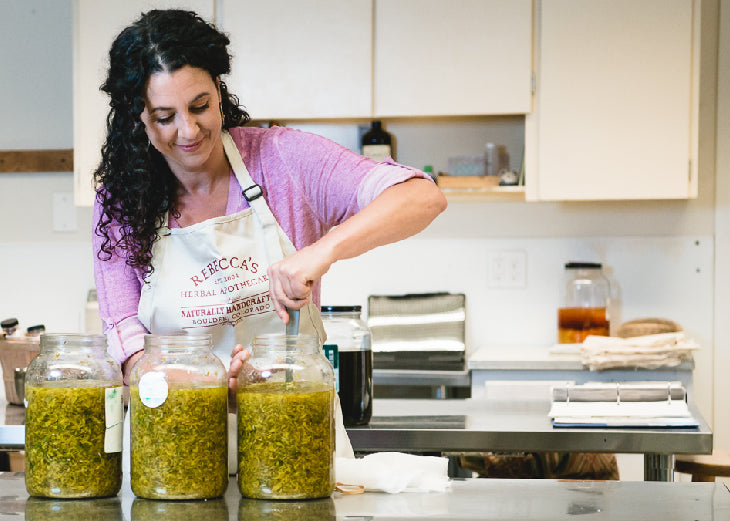Herb Article
Rosemary
By Alyson Gaioni
 Common Name
Common Name
Rosemary
Latin Name
Rosmarinus officinalis
Family
Lamiaceae
Parts used
Aerial parts
Medicinal Properties
Rosemary is a beautiful perennial herb with fragrant needles that smell like a deep, damp forest. A very hearty and drought resistant plant, Rosemary is easy to grow for beginning gardeners and is suited to Colorado's climate during the warmer months. The Latin name Rosmarinus means "dew of the sea" because of Rosemary's ability to live off no water source other than an ocean breeze. Most people know this amazing herb as a culinary spice, but are not familiar with its multitude of medicinal herbal uses.
Rosemary is such an amazing ally for this time of year. I tend to find myself drained and holding onto some tension from the holiday season. Rosemary has the remarkable ability to aid in recovery from long-term stress, raise the spirits, and soothe nervous tension. It is high in easily assimilable calcium, making it beneficial for the entire nervous system. As a warming herb, it has the added bonus of increasing peripheral circulation - perfect for chilly hands and feet during ski season! Due to its antimicrobial, antioxidant, and anti-inflammatory properties, Rosemary is also very useful for wintertime illnesses such as colds, flus, and respiratory congestion.
Rosemary has long been used to improve and strengthen memory, and is used in ceremony as a symbol of remembrance. As a circulatory stimulant, it increases oxygen supply to the brain which in turn improves memory and concentration. To this day, students in Greece will burn Rosemary before exams. This circulatory action can also ease headaches, migraines, and even encourage hair growth!
In addition to the plethora of medicinal uses, Rosemary has a deep and rich magical history as well. As one of the oldest incenses, it is thought that Rosemary can be burned to rid a place of negativity due to its powerful cleansing and purifying vibrations. Placed under your pillow at night, Rosemary is believed to ensure a good nights sleep and will drive away nightmares. If a sprig of the plant is placed under the bed, it protects the sleeper from harm.
Contraindications
As with many herbs, Rosemary may be contraindicated during pregnancy. Do not take higher doses than recommended or excessively while pregnant.
Preparations & Applications
Rosemary can be enjoyed as a culinary spice, tea, tincture, steam, and the essential oil may be used in aromatherapy.
Recipes
Relax and Smile Tea
1 part Chamomile
1 part Lemonbalm
1/4 part Rosemary
Infuse herbs in hot water using ratio 1 T herbs per cup of water. Steep for 5-15 minutes, strain, and enjoy!
Study Time Treat
(adapted from a Rosemary Gladstar recipe)
The perfect snack to stimulate your brain and taste buds!
Tahini or other nut butter
Honey, Agave, or other sweetener
1 part powdered Gotu Kola
1 part powdered Siberian Ginseng
1/2 part powdered Lycium berries
1/4 part powdered Rosemary
Cacao Nibs (optional)
Flaked Coconut (optional)
Chopped Almonds (optional)
Raisins (optional)
Carob Powder
Mix together equal parts tahini and honey (or to taste, depending on how sweet you want the end product to be). Add powdered herbs until the mixture is a thick batter or paste. Add any other treats you would like, such as cacao nibs, flaked coconut, chopped almonds or raisins. Add carob powder to thicken mixture into a dough. Roll into small balls, store in the refrigerator and enjoy! The recommended serving size is one ball a day.
Resources
Cunningham's Encyclopedia of Magical Herbs, Scott Cunningham
Encyclopedia of Herbal Medicine, Andrew Chevallier
Herbal Recipes for Vibrant Health, Rosemary Gladstar
The Way of the Herbs, Michael Tierra
 Common Name
Common NameRosemary
Latin Name
Rosmarinus officinalis
Family
Lamiaceae
Parts used
Aerial parts
Medicinal Properties
Rosemary is a beautiful perennial herb with fragrant needles that smell like a deep, damp forest. A very hearty and drought resistant plant, Rosemary is easy to grow for beginning gardeners and is suited to Colorado's climate during the warmer months. The Latin name Rosmarinus means "dew of the sea" because of Rosemary's ability to live off no water source other than an ocean breeze. Most people know this amazing herb as a culinary spice, but are not familiar with its multitude of medicinal herbal uses.
Rosemary is such an amazing ally for this time of year. I tend to find myself drained and holding onto some tension from the holiday season. Rosemary has the remarkable ability to aid in recovery from long-term stress, raise the spirits, and soothe nervous tension. It is high in easily assimilable calcium, making it beneficial for the entire nervous system. As a warming herb, it has the added bonus of increasing peripheral circulation - perfect for chilly hands and feet during ski season! Due to its antimicrobial, antioxidant, and anti-inflammatory properties, Rosemary is also very useful for wintertime illnesses such as colds, flus, and respiratory congestion.
Rosemary has long been used to improve and strengthen memory, and is used in ceremony as a symbol of remembrance. As a circulatory stimulant, it increases oxygen supply to the brain which in turn improves memory and concentration. To this day, students in Greece will burn Rosemary before exams. This circulatory action can also ease headaches, migraines, and even encourage hair growth!
In addition to the plethora of medicinal uses, Rosemary has a deep and rich magical history as well. As one of the oldest incenses, it is thought that Rosemary can be burned to rid a place of negativity due to its powerful cleansing and purifying vibrations. Placed under your pillow at night, Rosemary is believed to ensure a good nights sleep and will drive away nightmares. If a sprig of the plant is placed under the bed, it protects the sleeper from harm.
Contraindications
As with many herbs, Rosemary may be contraindicated during pregnancy. Do not take higher doses than recommended or excessively while pregnant.
Preparations & Applications
Rosemary can be enjoyed as a culinary spice, tea, tincture, steam, and the essential oil may be used in aromatherapy.
Recipes
Relax and Smile Tea
1 part Chamomile
1 part Lemonbalm
1/4 part Rosemary
Infuse herbs in hot water using ratio 1 T herbs per cup of water. Steep for 5-15 minutes, strain, and enjoy!
Study Time Treat
(adapted from a Rosemary Gladstar recipe)
The perfect snack to stimulate your brain and taste buds!
Tahini or other nut butter
Honey, Agave, or other sweetener
1 part powdered Gotu Kola
1 part powdered Siberian Ginseng
1/2 part powdered Lycium berries
1/4 part powdered Rosemary
Cacao Nibs (optional)
Flaked Coconut (optional)
Chopped Almonds (optional)
Raisins (optional)
Carob Powder
Mix together equal parts tahini and honey (or to taste, depending on how sweet you want the end product to be). Add powdered herbs until the mixture is a thick batter or paste. Add any other treats you would like, such as cacao nibs, flaked coconut, chopped almonds or raisins. Add carob powder to thicken mixture into a dough. Roll into small balls, store in the refrigerator and enjoy! The recommended serving size is one ball a day.
Resources
Cunningham's Encyclopedia of Magical Herbs, Scott Cunningham
Encyclopedia of Herbal Medicine, Andrew Chevallier
Herbal Recipes for Vibrant Health, Rosemary Gladstar
The Way of the Herbs, Michael Tierra




